5000 Words for Snow
When Paul Jaccard published his seminal work: “Étude comparative de la distribution florale dans une portion des Alpes et des Jura” in 1901 he definitely did not expect that his work on comparison of alpine meadow flowers’ biodiversity would be applied in the future to look at the successful builds of draft decks. But his methods of converting ecosystems to numbers are too useful to pass over. And surely it can’t be a coincidence that Alpine Meadow is in the set we are analysing today, can it?
Let’s start from the beginning. I am both a Magic player and a microbial ecologist. While playing cards has given me a surprisingly potent skillset in my non-Magic life, my professional training is also helpful in how I think about limited and cards in general. One concept I always wanted to apply to Magic is the comparison of similar ecosystems we often use in ecology. A limited metagame is like a planet. Each archetype is an ecosystem consisting of decks. Decks are samples of this larger ecosystem, like the sites on different alpine meadows prof. Jaccard was comparing in the early 20th century. Cards in those decks are like the meadow flower species - there is an overarching degree of similarity but each site (deck) has a slightly different species (card) composition. If that is the case, why can’t we use the same tools he did to compare decks within an archetype?
This idea was bubbling in my head for some time, but with the arrival of Kaldheim I finally found inspiration. Snow is significantly different from the ZNR archetypes, which were very well defined and stuck rigidly to their 2-colour combinations. Snow is wild. You can find almost anything, from streamlined mono green to a luxurious 5-colour extravaganza through all the combinations of (mostly) G, U, R and B. This makes it easy to compare decks within the mega-archetype and lets us try and figure out what makes particular snow decks more successful than others.
How should we compare those decks? Here is where the ideas of Jaccard and later ecologists come in handy. They designed a toolkit of comparing sampling sites to one another. Briefly, you convert the combinations of species from each site to numbers and plot them on a graph. The sites most similar to each other are closer on the graph, and based on that you can cluster sites that are very similar and look at the features that make them so. This is exactly what I’ve done with the snow decks from KHM.
I’ve defined a snow deck as one that has at least 5 snow lands and at least 5 snow permanents. This gave me over 4300 snow decks from the 17Lands database to compare. I plotted these in a two dimensional space for our human brains to understand (the solution of such analyses is normally multi-dimensional and impossible to grasp). The closer two decks are on such a graph, the more similar they are. The axes of the graph have no unit nor dimension, so I’ve omitted them to avoid confusion. For boring details of the analysis, read the methods note at the end. As you can see, the plotting of thousands of decks yields an incomprehensible blob of points. But what do they mean?
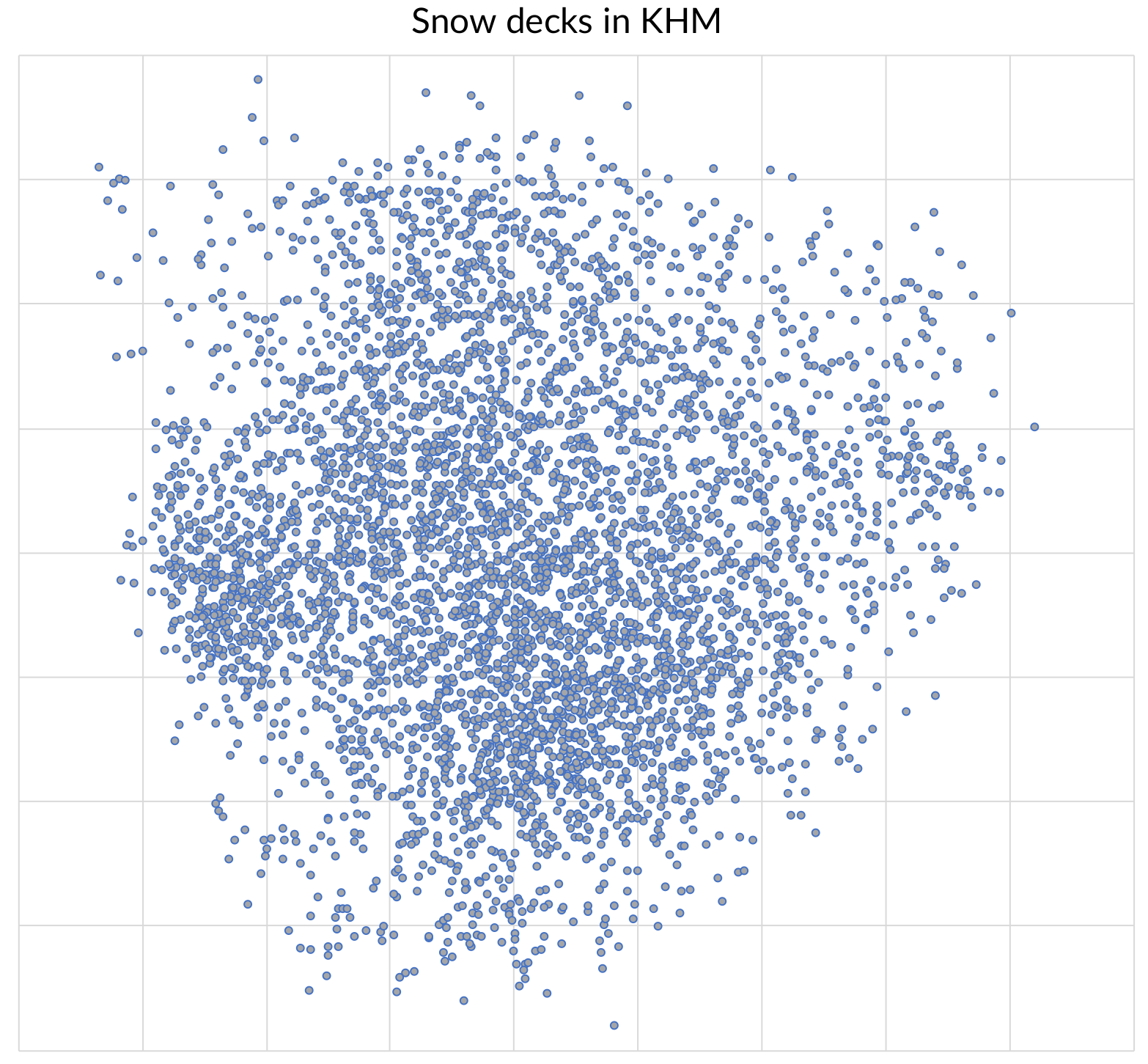 Fig. 1: Raw plot of the snow deck diversity
Fig. 1: Raw plot of the snow deck diversity
My first idea was to mark the win rates of the decks plotted. The idea was that there might be some visible clusters of decks that win more, and there were. On the graph below, you can see the results with some potential clusters marked. This gave me hope that I could identify some high win-rate pockets and look at the compositions of decks within those pockets to identify their defining features.
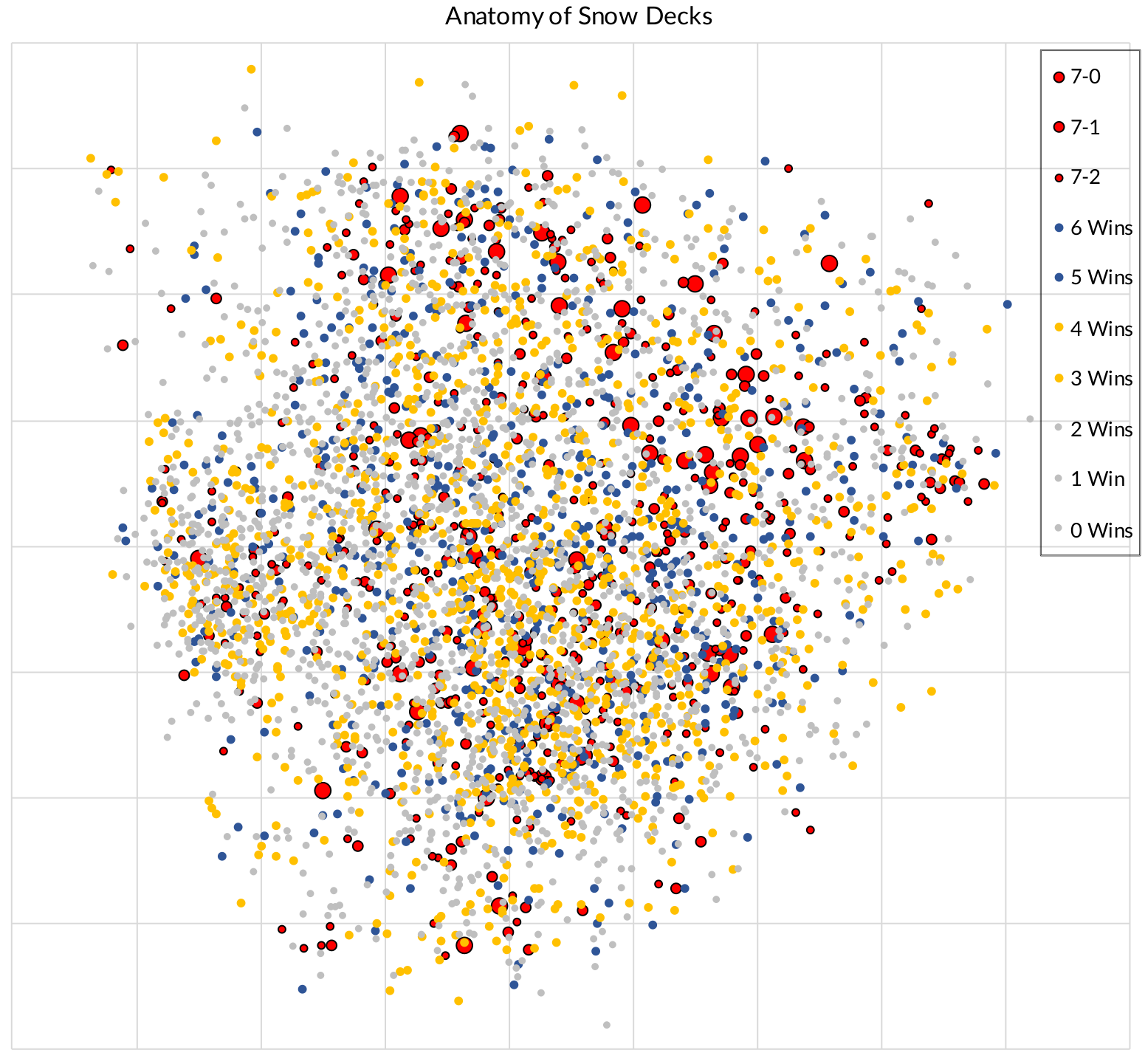 Fig. 2: Snow deck diversity plot with win rates of decks and promising clusters of decks more likely to win marked in red circles
Fig. 2: Snow deck diversity plot with win rates of decks and promising clusters of decks more likely to win marked in red circles
This was an encouraging result. I could see that the high win rate decks seem to cluster together to some extent. If they were all over the place, it would suggest that trophying is a very random result. Instead, there seems to be a method in drafting a winning deck. Now all I needed to find is a method of my own to be able to identify those pockets of high performers. The idea I had was to look at a heat map of win rates. I calculated the average win rate of a deck and its 10 closest neighbours for each of the 4300 decks.
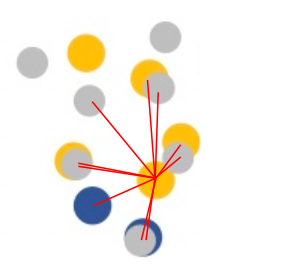 Fig. 3: A deck with its 10 closest neighbours. In this case the deck tested is medium (3-4 wins) and is neighbouring with 4 poor decks (0-2 wins), 4 medium (3-4 wins), and 2 decent (5-6 wins) decks.
Fig. 3: A deck with its 10 closest neighbours. In this case the deck tested is medium (3-4 wins) and is neighbouring with 4 poor decks (0-2 wins), 4 medium (3-4 wins), and 2 decent (5-6 wins) decks.
With the data of all decks with their closest neighbours calculated, I started to look at best and worst performers. I plotted all 4300 decks, but highlighted the points with 100 highest average win rates and 100 lowest win rates. The 100 winningest areas on the plot were surprisingly close to the areas I selected by eye but some additional areas popped out as well.
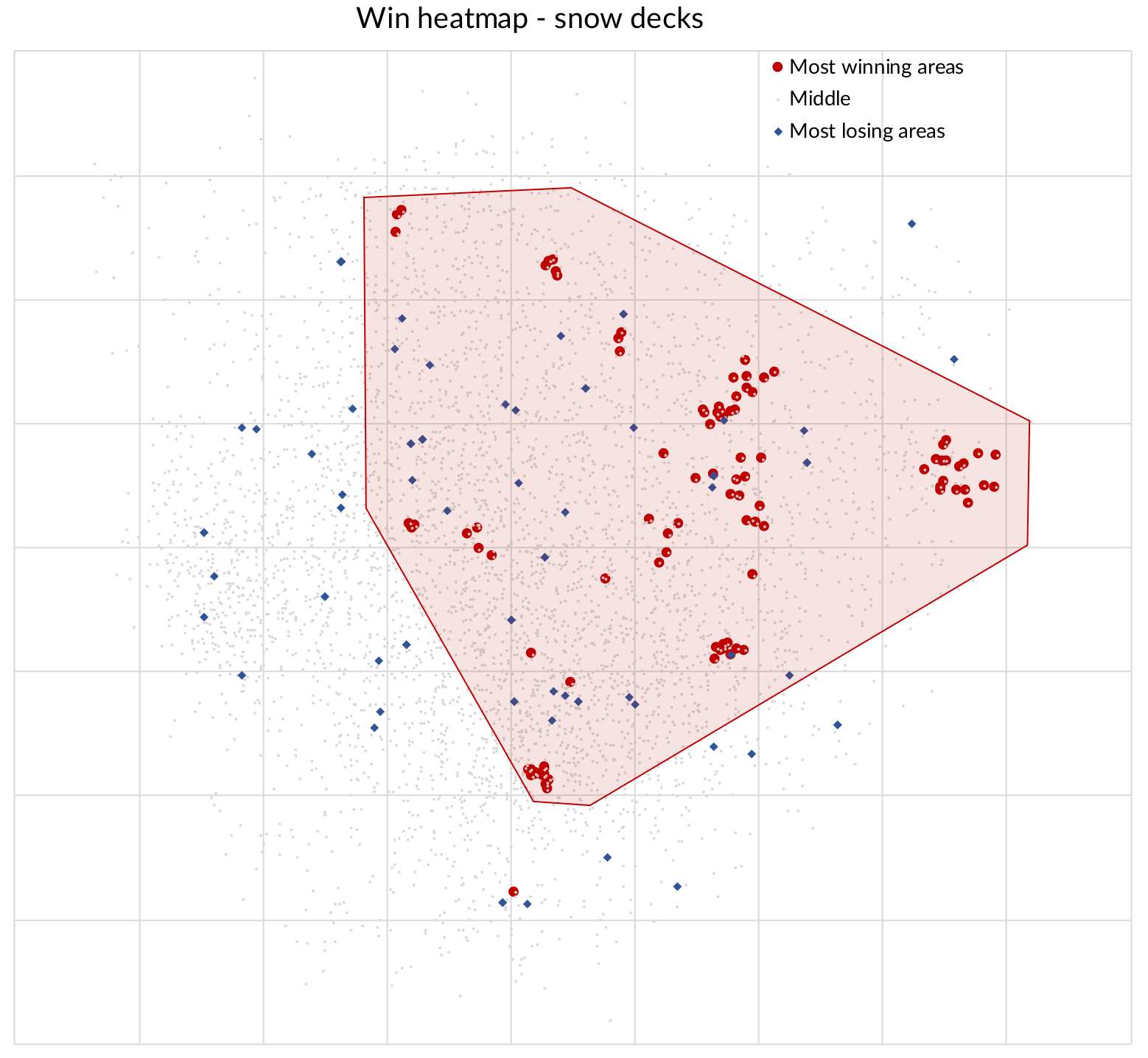 Fig. 4: Win heatmap of snow decks. The 100 winningest areas based on average win rate of a deck and its 10 closest neighbours are in red circles, 100 most losing decks based on the same criteria in blue diamonds. The remaining decks are the small grey spots. The shading indicates the area where most successful decks reside.
Fig. 4: Win heatmap of snow decks. The 100 winningest areas based on average win rate of a deck and its 10 closest neighbours are in red circles, 100 most losing decks based on the same criteria in blue diamonds. The remaining decks are the small grey spots. The shading indicates the area where most successful decks reside.
Here we get to some interesting results. The first thing that strikes me are clear clusters of winning decks, which is the basis of further analyses. If decks are similar and have high win rates, you can look at compositions of those and find key features that can give you hints on why those decks are successful. The second thing that strikes me is the lack of such clear clustering in the losing decks. This is important as it suggests that there is no real recipe for disaster. Losing decks are peppered all over the plot. Some are even nested in clusters of winning decks, showing how razor thin a margin between a trophy and a failure can be. Even a good looking deck is a couple of bad draws, a couple of small misplays or a couple of unlucky pairings away from going 0-3.
Another look at the graph can show a careful observer that the pockets of winning decks are not necessarily located in most densely populated areas of the plot, which points towards the idea that the decks in question are not random piles but more coherent decks drafted with a plan and not created simply by what snow payoffs were floating across the table. Or that there are some defining features of good snow decks that are not universally shared by all of them - quite the opposite.
What are the compositions of these decks? How similar are the decks within each winning cluster? The good news is, they are quite similar. Each small cluster roughly represents a colour combination. By comparing the composition, we can convert meaningless blobs (Fig. 5 left) into something telling to Magic players (Fig. 5 right):
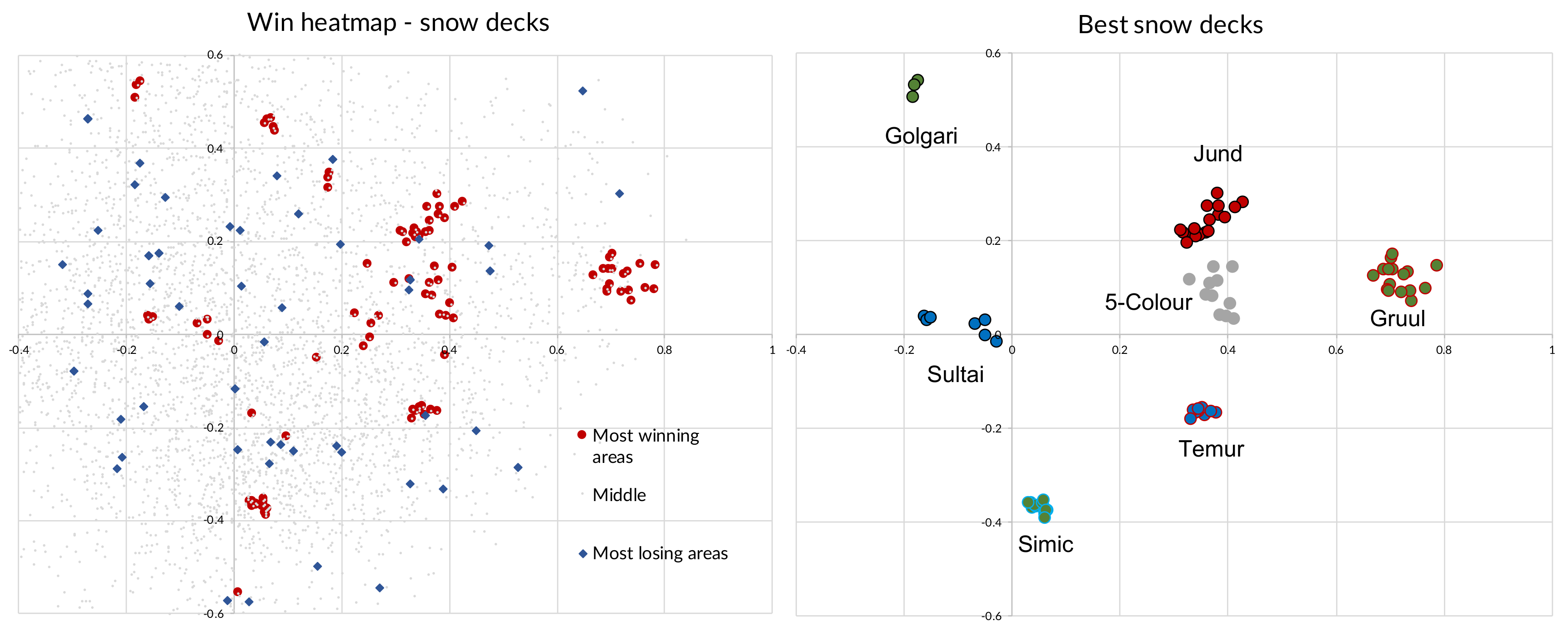 Fig. 5: Winning clusters (left panel), selected winning clusters based on their colour identity (right). The area of the plot is zoomed into the shaded area from Fig. 4.
Fig. 5: Winning clusters (left panel), selected winning clusters based on their colour identity (right). The area of the plot is zoomed into the shaded area from Fig. 4.
As you can see, the winning decks divide into roughly 7 clusters, and these represent colour combinations of green, blue, red, and black. 5-colour decks occupy the space in the middle, 2-colour combinations are located on the peripheries of the graph with 3-colour decks in between. It looks that the snow decks, even though combining characteristics of multiple colours, come in several varieties and have accordingly adjusted plans. With that background, we can now dive into each cluster and briefly see what is going on in each of them. I will give you several statistics of each archetype and the most dominant cards in each cluster.
Gruul
Averages
- Creatures: 15
- Snow Lands: 6
- Snow Permanents: 6
- Snow Spells: 1.5
- Casting Cost: 3.01
Most common cards
Cards present in 50% or more decks from the cluster in order from most to least popular; cards on the same line are equally popular
Icehide Troll Sculptor of Winter Svella, Ice Shaper Boreal Outrider ,Frost Bite ,Spirit of the Aldergard Axgard Cavalry ,Tuskeri Firewalker Arni Slays the Troll ,Demon Bolt ,Hagi Mob ,Ravenous Lindwurm ,Struggle for Skemfar
This archetype looks like a down-to-the-ground aggro deck with a slight twist. Instead of clunky 4 drops like the
Unlike other snow decks, this one really wants to be 2-coloured. Only 18% of the decks had any splashes, choosing a streamlined RG plan over more durdly multicolour games. It also relied on many RG staples from the non-snow decks.
This is also a great home for snow spells. Average of 1.5 snow spells per deck was achieved mainly thanks to
In conclusion, successful Gruul snow builds take the traditional Gruul shell and build on it by incorporating snow synergies. The cost related to having to pick snow lands is compensated for by access to more cards that fit in the decks, some of them very powerful even with relatively low snow counts. The strength of this build is related to draft flexibility (Snow lands not available? Just revert to regular Gruul aggro) and to how the snow cards synergise well with the deck plan.
Simic
Averages
- Creatures: 13.9
- Snow Lands: 6.6
- Snow Permanents: 7
- Snow Spells: 0.6
- Casting Cost: 3.2
Most common cards
Mistwalker Spirit of the Aldergard Berg Strider ,Littjara Kinseekers Behold the Multiverse ,Sarulf's Packmate ,Sculptor of Winter Bind the Monster ,Giant's Amulet ,Icehide Troll ,Masked Vandal ,Moritte of the Frost
Successful Simic snow builds look very much like a midrange deck. Playing defensively early on, the deck aims to turn the corner in the midgame and annihilate the opponent. Early stabilising is achieved with
The deck is different from Gruul in several aspects. Firstly, it splashes more readily. Over 85% of the decks from the cluster had a splash, mainly splashing red. This was normally a small splash of 1-2 cards (most commonly
Between
In conclusion, UG snow wants to clog the board early and win the game holding the fort while attacking with evasive threats. The decks splash frequently (in small quantities). They have a middle-heavy mana curve with many 4- and 5-drops. Card draw looks essential to avoid missing land drops and to be able to deploy the threats as early as possible.
Golgari
Averages
- Creatures: 15.3
- Snow Lands: 7.1
- Snow Permanents: 8.4
- Snow Spells: 0.3
- Casting Cost: 3.23
Most common cards
Priest of the Haunted Edge Glittering Frost ,Icehide Troll ,Ravenous Lindwurm ,Sculptor of Winter Binding the Old Gods ,Elderfang Disciple ,Feed the Serpent ,Grizzled Outrider ,Spirit of the Aldergard ,Svella, Ice Shaper
The Golgari snow decks are surprisingly creature heavy. Surprising until you realise that they depend on
If the Priests are the early control package, big creatures ramped out with the help of
Since it needs quite some snow lands to make sure
Being relatively snow-heavy and midrange but still aggressively slanted, two cards that were common in the deck were
The deck uses “speed bump” cards to perfection. This is a great home for
To conclude, Golgari is the ramp deck, using Priest to stop getting the damage and later eliminate most dangerous threats, ramping to large beasts who will finish the game. You survive till then by a combination of removal and speed bump utility creatures that can be chucked away, recouped, and reused.
Jund
Averages
- Creatures: 14.6
- Snow Lands: 8.8
- Snow Permanents: 7.7
- Snow Spells: 0.9
- Casting Cost: 3.14
Most common cards
Svella, Ice Shaper Icehide Troll ,Sculptor of Winter Horizon Seeker Priest of the Haunted Edge ,Sarulf's Packmate ,Spirit of the Aldergard Glittering Frost ,Ravenous Lindwurm Demon Bolt ,Masked Vandal
Are you starting to get the idea
With low competition for snow, you will be able to get at least 4 of those 5 cards reliably.
Good snow Jund decks are not really Jund to be fair. They are a slightly different, Black-leaning version of 5c snow, but it clusters separately and has a mana composition sufficiently different I decided to call it Jund. This deck is really heavy on snow lands. It’s hard to say if the 5-colour nature of it is related to wanting more snow lands and ending with all colours or vice versa, drafting all colours was a plan from the beginning.
This deeper dive into a multicolour deck is most likely the reason why we see
Temur
Averages
- Creatures: 13.1
- Snow Lands: 8.1
- Snow Permanents: 6.4
- Snow Spells: 1.4
- Casting Cost: 3.27
Most common cards
Glittering Frost Behold the Multiverse Arni Slays the Troll ,Guardian Gladewalker ,Icehide Troll ,Masked Vandal ,Svella, Ice Shaper Ravenous Lindwurm ,Sarulf's Packmate
Temur snow looks, again, surprisingly similar to previous archetypes. I was expecting more of a giants- and shapeshifters-themed pile; instead I can see a midrange deck using Gruul creatures for early and late game and some blue to keep the cards running and to help and turn a corner. Lots of blue was not sufficiently represented to be in over 50% of games, but
The most common card in this build is
Sultai
Averages
- Creatures: 13.8
- Snow Lands: 8.4
- Snow Permanents: 8.4
- Snow Spells: 1.3
- Casting Cost: 3.28
Most common cards
Glittering Frost Narfi, Betrayer King Berg Strider ;Blessing of Frost ;Masked Vandal ;Mistwalker ;Pilfering Hawk ;Priest of the Haunted Edge ;Sculptor of Winter
Sultai, looking at the data, is a focused 3 colour deck. Not many splashes, unlike Jund and Temur. It uses an advantage it has over any other snow pile (barring 5 colours): being able to play
Aside from
5-Colour
Averages
- Creatures: 13.1
- Snow Lands: 8.9
- Snow Permanents: 7.1
- Snow Spells: 0.7
- Casting Cost: 3.26
Most common cards
Demon Bolt ,Glittering Frost ,Sarulf's Packmate ,Sculptor of Winter Binding the Old Gods ,Horizon Seeker Icehide Troll ,Path to the World Tree Frost Bite ,Priest of the Haunted Edge ,Svella, Ice Shaper
Perhaps unsurprisingly, the core of 5-colour snow is designed to make you survive until the late game.
This seems to be an overarching theme of the snow archetype that emerges from the data we analysed. The decks, even though different from each other, have a large overlap. Except for a more aggro tinted Gruul variant, most of the successful snow builds focus on early development and survival, and then start generating card advantage with the most powerful stuff available. Cards that can be seen over and over again are
Individual Cards
Apart from looking at decks and their relatedness, I also looked at individual cards and their general performance in snow decks. Busted rares aside, the cards with highest win rates when drawn in snow decks were
There are some cards that increase your win rate when drawn (during game or opening hand) as opposed to when you don’t draw them, which is a slightly stronger signal that a card is good. Some examples of those are
Snow looks very interesting and has infinite capabilities to build a deck around it. I really hope that this analysis sheds at least some light on the subtle but key differences between some of the successful snow builds, but more importantly I really hope it shows that the similarities across the archetypes are equally important and highlight crucial cards responsible for winning strategy: cards that stabilise the game. Snow is at its weakest in the early stages of the game and the data clearly suggests that removing that problem is the key to winning and trophying. The late game threats are secondary to the early plays and you should draft prioritising early stabilisers, speed bumps and lands rather than focusing on late game drops.
Methods note:
The data was taken from 17Lands.com. The dataset was extracted on the 9th of February, so do not be surprised if it is not exactly the same as the current one. To analyse the snow decks, I used a Bray Curtis dissimilarity, first described in “An ordination of upland forest communities of southern Wisconsin.” in 1957. I mean come on Bray and Curtis, why not
As always this analysis is only possible thanks to dedication of the 17Lands team. Thanks guys, you are relentless and deserve all the credit for all the amazing things you do. Thanks to Hululu, Viralmisnomer and Grantwu for all the suggestions and corrections and to SLKerstens for comments on the article that helped clarify it.
Do you want to help contribute data for analyses like these in the future? Check out our Getting Started page to install the lightweight Arena tracker and get access to all of our deck, draft, and gameplay tracking!